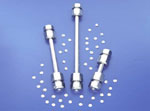|
|
DiamondBondTM-C18
Column Companion
General Method Development Guidelines
- Begin with an organic rich mobile phase, and decrease
organic content in increments of 10% to achieve elution of compounds with k’ ranging
from 1 to 20.
- Change from one organic modifier to another (i.e. ACN,
Methanol, THF) to enhance chromatographic selectivity and improve peak shape and
efficiency.
- For ionic compounds change the buffer pH and composition to
enhance selectivity and improve peak shape.
- Increase the ionic strength of the buffer system to improve
peak shape of highly ionizable analytes.
- Increase the operating temperature to decrease analysis
time and improve peak shape and efficiency.
For Neutral Compounds...
- Use Acetonitrile or THF / Water mobile phases with at least
5% THF present.
- The composition of the organic modifier may be adjusted to
provide maximum efficiency, selectivity, and the best peak shape.
- Use elevated operating temperatures when possible and as
allowed by the stability of the analyte.
- Use higher percentages of THF in the mobile phase for
highly polar and polyaromatic compounds.
For Acidic Compounds...
- Use at least 20mM phosphate buffer systems for the aqueous
component of the mobile phase, using phosphoric acid as the phosphate source at very low
pH.
- The addition of a fluoride salt may be useful when
operating above pH 4.
- The use of ammonium salts of fluoride and phosphate is
preferred over the sodium and potassium salts.
- A minimum of 5% THF organic modifier is recommended for
improved peak shape.
- DiamondBondTM-C18 columns are
stable even at pH 1.
For Basic Compounds...
- Use at least 20mM phosphate buffer systems for the aqueous
component of the mobile phase.
- The use of the ammonium salt of phosphate is preferred over
the sodium and potassium salts.
- DiamondBondTM-C18 columns are
stable even at pH 14.
Improving Difficult
Separations
- For very basic compounds with pKa’s greater than 10,
operate the column at the maximum temperature allowed by the HPLC system. When doing this,
one may need to lower the organic content to maintain enough retention.
- For zwitterionic compounds, increase the ionic strength of
the buffer system and adjust the pH until a suitable separation is achieved, while
operating at a high column temperature.
Recommendations
for the Analysis of Ionizable and Non-ionizable Compounds on DiamondBondTM-C18

For information on ZirChrom®
products feel free to contact us online.
|












